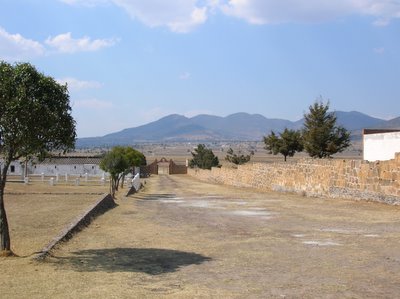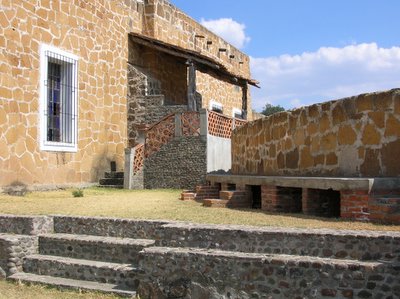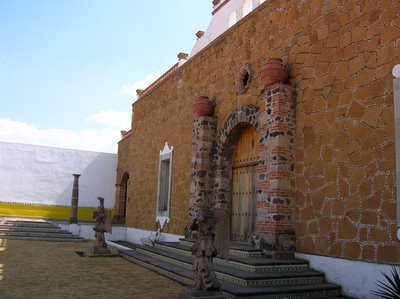Katy's Asia Adventures (plus Mexico!) |
|
|
A haphazard chronicle of my inevitable misadventures during a year in Vietnam and points east. p.s. I'll be pitifully grateful if you send me email during my exile: TravelerKaty@hotmail.com October 2002 November 2002 December 2002 January 2003 February 2003 March 2003 April 2003 May 2003 June 2003 July 2003 August 2003 September 2003 October 2003 November 2003 February 2006 March 2006 May 2006
Archives
|
Monday, February 27, 2006
 Day 6 - Part 2 - Hacienda La Laguna Day 6 - Part 2 - Hacienda La Laguna2/16/06 I'm getting a reputation as quite a talker in my family. Actually more of an interrogator, to be honest. There is a confluence of issues here -- I am intensely curious about people's lives, culture, government, hometown, pets, whatever, so I will take almost any opportunity to grill a willing victim, be it cab driver or passerby. At the same time, I have a look about me that I would describe as Utterly Harmless, which means that it is not at all unusual for strangers to ask me for directions or strike up a random conversation. Indeed, I have learned that even to emit the strongest back-the-hell-off vibes, as when I am in a bus simultaneously reading a book, listening to a walkman and spreading my bags over the adjoining seat, people will still attempt to engage me in idle (or insane, depending on the mental health of my new seatmate) chit-chat. Because of this well-known propensity, it was not surprising that our morning walk was slightly derailed as a woman down the road waylaid me with five minutes of curious questions. Nor was it unexpected that I eventually hogged the front seat of our van during our afternoon outing, unable to contain myself from attacking Ruben, our jolly driver, shotgun style with questions ranging from Mexican telenovelas to the probable outcome of the upcoming national elections to the legality of betting on cockfights. Fortunately for me, the trip was six hours long and the driver was basically captive; fortunately for Ruben and my family, I ran out of questions and conversation after about four hours. Our afternoon tour took us much farther afield than our previous jaunts. Through Jon we arranged to have chatty Ruben take us to the northern part of Tlaxcala state to check out a couple of haciendas. And Ruben had a van! No more smooshing 4 passengers into the japanese compact taxicab! It was obvious from the outset that we were to be the guinea pigs for a future mini-business in Hacienda Tours. We were warned by Ruben that the hacendados didn't know we were coming, and that if we couldn't get into the first ones he had several others to choose from. As it turned out, apart from a few wrong turns quickly corrected (generally be the use of mid-street U-turns) all went exactly planned with no alternate sites required. Ruben was thrilled at our luck and success at his first Hacienda Tour attempt, as were we.  Haciendas were not just where the very rich lived back in the day. During the 17th, 18th and into the 19th century they were the very core of the economy of Tlaxcala state and most of the Spanish colonial empire in America. They were mostly self-sufficient and served as mini-villages with possibly hundreds of workers and their families residing on the property and raising food, animals, pulque, and even conducting full mining operations in some areas of Mexico. Workers at plantations (called peones), were effectively treated as slaves. They could be sold, their daughters could be taken for whatever purposes the hacendado had in mind, etc. Today, after numerous revolutions (particulary the final one of 1910) and land reforms, most of the haciendas have been broken up, though the the cattle-breeding haciendas were allowed to survuve under special certificates signed by the new Mexican president. Those dominated by agriculture and pulque production were less lucky - most were sold off in parts after the 1917 land reform. Haciendas were not just where the very rich lived back in the day. During the 17th, 18th and into the 19th century they were the very core of the economy of Tlaxcala state and most of the Spanish colonial empire in America. They were mostly self-sufficient and served as mini-villages with possibly hundreds of workers and their families residing on the property and raising food, animals, pulque, and even conducting full mining operations in some areas of Mexico. Workers at plantations (called peones), were effectively treated as slaves. They could be sold, their daughters could be taken for whatever purposes the hacendado had in mind, etc. Today, after numerous revolutions (particulary the final one of 1910) and land reforms, most of the haciendas have been broken up, though the the cattle-breeding haciendas were allowed to survuve under special certificates signed by the new Mexican president. Those dominated by agriculture and pulque production were less lucky - most were sold off in parts after the 1917 land reform.As an aside, when we first met Ruben he (as a result of my usual interrogation as to his antecedents) told me a colorful tale of his ancestors. His grandfather (probably great or great-great) was the owner of a hacienda, and in 1910 had just married Ruben's grandmother, a 15-year-old from another great family who was expecting their first child. When the Zapatistas came, his grandparents begged them to let them go unharmed. The leader relented, saying that if he saw them again he would kill them and anyone else around them. So the two of them and their family packed up in the dead of night, filled a belt with all the gold and money they could get their hands on, and fled to Puebla, never to return to the Hacienda. They ended up having 9 children and living out their lives in Puebla. Great story, eh? Let's just decide to suspend our critical faculties and believe it all, for Ruben's sake. Cattle breeding, fighting bulls to be specific, was the primary occupation of our first hacienda, La Laguna. Since we were completely uninvited, permission to see the place was our first order of business. We all piled out of the van, Ruben being of the opinion that our presence would exert a powerful pressure on the hacendado to allow us to walk around . As it happens, I would not have missed meeting this guy for anything. Very much of the quien-es-mas-macho variety of Mexican male, the owner, an engineer by trade, exuded superiority from every pore. Dressed in a skintight red Ferrari sweatshirt and figure-hugging black pants, his attitude indicated that this was what the Conquistadors should have been wearing. The mustache, however, was his crowning glory. Such full, flowing, dramatic mustaches could be enclosed in glass cases and displayed in museums with captions such as "Symbol of the Glorious Conquest of Mexico." Sadly, I was too chicken to ask for a photo. Even I, who had seemingly taken thousands of photos already, was intimidated by The Mustache (or El Bigote in espanol).   On the left - an artist's rendering of our Hacendado if he were a low-rent Mexican cowboy actor. The mustache is a little weak, but the attitude is spot on. On the left - an artist's rendering of our Hacendado if he were a low-rent Mexican cowboy actor. The mustache is a little weak, but the attitude is spot on. On the right - General Ambrose Burnside, who lacks the proper I-tolerate-the-little-people aura but whose mustache is a fairly close approximation. The good news was that even though we interrupted his lunch, The Mustache was very accomodating, dispatching his minion Hector, AKA the ranch manager, to show us around. I rather thought we inturrupted Hector's siesta, but he was nothing but helpful and friendly, submitting genially to my usual raft of questions, this time mostly about raising and fighting bulls.  In addition to cattle raising, which is apparently not an extremely lucrative proposition these days (hence The Mustache's day job), La Laguna also had a thriving business in large and small scale parties in the courtyards, and also rented out five of its rooms as a bed-and-breakfast. I would have to think they must offer more of a bread-and- breakfast- and-lunch- and-dinner given how far off the main road it is. The nearest town was the very accurately named "Ciudad Industrial," which appeared to consist of about 20 factories, a very overdesigned road system, and virtually no residential or commercial offerings. In addition to cattle raising, which is apparently not an extremely lucrative proposition these days (hence The Mustache's day job), La Laguna also had a thriving business in large and small scale parties in the courtyards, and also rented out five of its rooms as a bed-and-breakfast. I would have to think they must offer more of a bread-and- breakfast- and-lunch- and-dinner given how far off the main road it is. The nearest town was the very accurately named "Ciudad Industrial," which appeared to consist of about 20 factories, a very overdesigned road system, and virtually no residential or commercial offerings.The rooms were very high ceilinged, with the usual gorgeous round fireplaces built into one corner and a decorative cow hide covering most of the tile flor at the foot of the bed. all the rooms opened onto a walkway around the large courtyard (complete with giant party tent in preparation for the 500 guests attending a baptism the following weekend). The tiled walkway was lined with wooden benches, framed corrida posters and huge bull heads. These were Los Machos - the bulls that after a distinguished fighting career (which consists of one fight, not to the death, in the Mexican version of bullfighting), their ears were cut off and presented to the torero and the bull was sent back home to La Laguna to provide years of stud services. This little article gives more info about raising and fighting bulls in Mexico, and even has a nice mention about La Laguna: Today, the State of Tlaxcala has the largest number of bull breeding ranches or ganaderias–a total of 40, followed by the States of Guanajuato and Jalisco. The premier ranch is Ganaderia La Laguna de Terrenate, founded in 1908 by Don Romareo Gonzalez, with cows from Tepeyahualco and a breeding bull from Ibarra. It has had more winners at the Plaza Mexico in Mexico City–23 to date–than any other breeding ranch in Mexico.Good choice, Ruben!  A modest little chapel for 70 (right) or so was located at one end of the courtyard, with a simple white interior, dark paintings and a couple of very old statues. At the other end, a living area with conversationally placed plush couches was provided for guests and an airy tiled kitchen with a modern cow theme contrasted with the more formal dining room with its heavy wood furniture and large round table. A modest little chapel for 70 (right) or so was located at one end of the courtyard, with a simple white interior, dark paintings and a couple of very old statues. At the other end, a living area with conversationally placed plush couches was provided for guests and an airy tiled kitchen with a modern cow theme contrasted with the more formal dining room with its heavy wood furniture and large round table.Outside, the bull testing ring adjoined the main Spanish-style stone building. While The Mustache and others watch from the little bandstand, young bulls would be brought into the ring. The torero, already positioned inside the ring, will make a few passes to see how the bull reacts, then the picador on the horse gets a shot at it. Bulls that run the other way are destined for the dinner table. Feistier bulls who lack horns that point forward might end up in festivals and novice corridas for younger bulls and bullfighters, while those with both temperament, looks, and suitably dangerous horns will continue to live a life of leisure on the ranch until they are tapped to fight at around age four. Bulls that put up a good fight and showcase the torero's valor and talent to good effect will have an ear or two removed and presented to the torero with great ceremony. These bulls will return to the ganaderia with more chance of a life of servicing cows and less chance of becoming carne asada. Some of these successful bulls are sold to other ganaderias as breeding animals as well.  The countryside is desert-like, with dry hills all around and various varieties of cacti and scrub. To get to the bulls themselves we rolled over dirt tracks even worse than the road to the hacienda, and through a security system consisting of a series of barbed-wire gates. One would not wish for an unexpected encounter with a free-ranging fighting bull. Each herd of bulls contained one "Macho" and about 20-40 younger upstarts, including one calf just 10 days old. We stayed in the van and took photos through closed windows. No need to become a Stupid Tourist Tragedy. Although they were small -- Mexican fighting bulls are smaller than their Spanish counterparts and smaller still than American rodeo bulls -- they still looked pretty ticked off and I would not relish those horns and that personality betwen me and the safety of the vehicle. The countryside is desert-like, with dry hills all around and various varieties of cacti and scrub. To get to the bulls themselves we rolled over dirt tracks even worse than the road to the hacienda, and through a security system consisting of a series of barbed-wire gates. One would not wish for an unexpected encounter with a free-ranging fighting bull. Each herd of bulls contained one "Macho" and about 20-40 younger upstarts, including one calf just 10 days old. We stayed in the van and took photos through closed windows. No need to become a Stupid Tourist Tragedy. Although they were small -- Mexican fighting bulls are smaller than their Spanish counterparts and smaller still than American rodeo bulls -- they still looked pretty ticked off and I would not relish those horns and that personality betwen me and the safety of the vehicle.After a final Audience with The Mustache, in which more kisses and profuse thank yous were exchanged, we turned north again, only briefly getting turned around in the inexplicable maze-like Ciudad Industrial. Next stop - Hacienda #2, a considerably more down-at-heel example, to be discussed in Part 3. More photos:  View from the grandstand as Ruben makes like a torero in the practice ring. View from the grandstand as Ruben makes like a torero in the practice ring. Walkway around the courtyard leading into Chapel. Walkway around the courtyard leading into Chapel. Might as well make use of the whole bull. Might as well make use of the whole bull. Toro! Toro! Toro! Toro! Toro! Toro!© 2006 Katy Warren
Comments:
Post a Comment
|